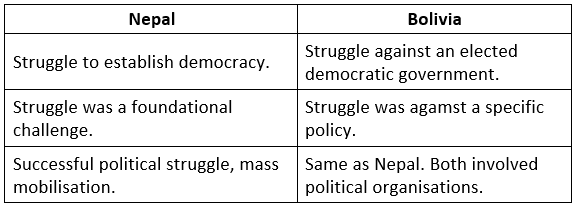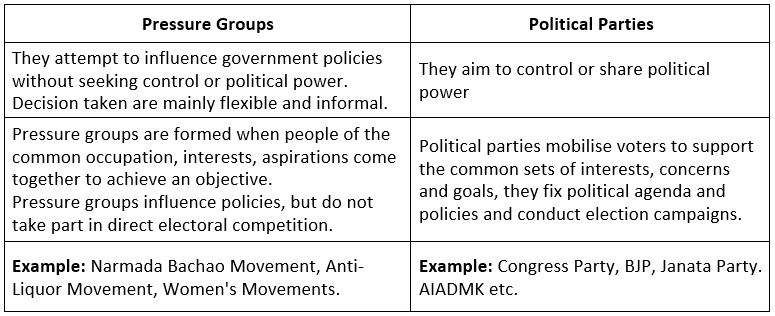Key Concepts: Popular Struggles & Movements - Class 10 PDF Download
| Table of contents |

|
| Movement for Democracy in Nepal |

|
| Bolivia's Water War |

|
| Conclusion |

|
| Mobilisation and Organisation |

|
| SECTIONAL INTEREST GROUPS AND PUBLIC INTEREST GROUPS |

|
| Kinds of Movement Groups |

|
Movement for Democracy in Nepal
Cause
- The movement began in 2006. It was a movement to restore democracy which was established in 1990.
- The king had become the head of the state then, but the real power was in the hands of the elected representatives.
- King Birendra, who had accepted Constitutional Monarchy, was killed in a mysterious massacre of the royal family in 2001.
- The new king, Gyanendra, refused to accept the democratic rule. He dismissed the democratically elected government, dissolved the Parliament and seized power in February 2005. A movement began in April 2006 to take away power from the king.
Movement
- All major political parties formed a Seven Party Alliance (SPA).
- They called for a ‘four day strike’ in Kathmandu, the capital of Nepal.
- Maoist insurgents joined the strike along with other groups and turned it into an indefinite strike. People defied the curfew and took to streets. The security forces could not cope with more than a lakh people demanding democracy every day. On 21 April, they served an ultimatum to the king.
Their demands were:
- A new Constituent Assembly
- Restoration of Parliament
- An All-Party Government
Result
- The king had to bow down on 24 April, 2006. The king agreed to all the three demands and lost most of his powers.
- The Maoists and SPA agreed to have a new Constituentm Assembly.
- G.P. Koirala became the new Prime Minister of Nepal.
- From an absolute monarchy, Nepal became a democracy, after a second movement for democracy.Question for Key Concepts: Popular Struggles & MovementsTry yourself:What were the demands of the movement in Nepal to restore democracy?View Solution
Bolivia's Water War
- Establishing democracy is not enough (as in Poland or Nepal). Popular struggles combine even after establishment of democracy, as in Bolivia.
- Bolivia, a poor country in Latin America, sold its municipal water supply rights to a multinational company (MNC). This she was forced to do by the World Bank. The city chosen was Cochabamba. The company raised the price of water four times. People who earned only Rs 5000 a month had to pay Rs 1000 a month for water.
- People rose as one man joined by labour human rights and community leaders in January 2000. Strikes after strikes occurred which the Government suppressed brutally. It even imposed martial law in April.
Result
- The officials of the MNC fled from the city. The government bowed to the people’s power and the water supply was restored to the Municipality. This event was known as Bolivia’s water war.
Table: Differences and Similarities between the Two Countries
Conclusion
- Democracy evolves through political struggles.
- Conflict in a democracy between those who exercise power, and those who want a share in it.
- These conflicts happen when:
(i) a country goes through a transition to democracy
(ii) expansion of democracy
(iii) deepening of democracy. - The conflict in a democracy is solved through mass mobilisation or institutions like the parliament or the judiciary.
- Agencies of organised politics help these movements.
- Agencies: Political parties, Pressure groups and Movement groups.
Mobilisation and Organisation
Important Features of Struggle in Nepal
- Call for indefinite strike was given by the Seven Party Alliance. The alliance had some members of the Parliament and members of some other big parties.
- SPA was not the only organisation supporting the mass upsurge. Nepalese Communist Party (Maoist) was also a part of it. It did not believe in parliamentary democracy. It had opposed the Nepali government and controlled large parts of Nepal. The others who supported were:
(i) All major labour unions and their federations
(ii) Organisations like those of teachers, lawyers, human rights groups.
Important Features of Struggle in Bolivia
- No political party led the struggle.
- An organisation comprising local professionals, engineers and environmentalists, supported by farmers who supported irrigation, a confederation of factory workers’ unions, middle-class students from the University of Cochabamba and street children who had no homes to go to, all of them together formed the FEDECOR.
- Later, they were supported by the party which came to power in Bolivia in 2006.
Conclusion
(i) In a democracy, any big struggle has many different organisations behind it.
(ii) Their role has two features:
- To influence decisions, direct participation in competitive politics. How? By creating parties, contesting elections and forming governments.
- Indirect participation by people. This is done by promoting organisations, called interest groups or pressure groups.
Table: Pressure Groups and Movements
SECTIONAL INTEREST GROUPS AND PUBLIC INTEREST GROUPS
1. Interest Groups: They seek to promote the interest of a particular section or group of society.
Example: Trade unions, business associations, and professionals (lawyers, doctors, teachers, etc.). They represent a section of society.
Aim: To seek betterment and well-being of their members, not society in general.
Important: Sometimes other organisations join them as they represent some common or general interests.
- In Nepal — the human rights organisations joined the struggle for democracy.
- In Bolivia, FEDECOR is another example. Opposing water privatisation was of general interest to all.
2. Public Interest Groups: They promote collective good as opposed to selective good.
They support or help groups other than their own members.
Example: A group fighting bonded labour fights for everyone who is suffering under such bondage. BAMCEF (Backward and Minorities Community Employees Federation) campaigns against caste distinctions or discrimination. Its principal concern is with social justice and social equality for the whole society.
Kinds of Movement Groups
- There are some who fight for a specific issue and have a single objective which they want to achieve in a specific, limited period of time.
Specific Issue: People were displaced by the creation of this dam on the Narmada river.
Objective: To stop the dam from being built. Later, it took up the issues of all big dams and the model of development that requires such dams. Their active life is short. The Nepal movement had also one issue, the restoration of democracy. - There are some who have a general or broad goal to fight for the long term.
Example: Narmada Bachao Andolan. - There are movements that are long-term and involve more than one issue.
Examples: Women’s issues, Environmental movements. No single organisation controls them or guides them.
Environmental movements are organised by a number of organisations or groups and each has a specific issue to deal with.
National Alliance for People’s Movements (NAPM) is one such organisation. It coordinates a large number of people’s movements in our country.
HOW DO THESE PRESSURE GROUPS AND MOVEMENTS INFLUENCE POLITICS?
- They try to gain public support and sympathy for their goals.
- Organise meetings, file petitions, carry out information campaigns by making the media take interest in the issues raised by them.
- They organise protests, strikes and other disruptive movements to prevent the government programmes.
- Business groups often sponsor expensive advertisements or employ professional lobbyists. Sometimes they join official bodies or committees that advise the government.
- Interest groups influence political parties. They have political ideologies and political positions on major issues.
- Sometimes the pressure groups are offshoots of political parties, either formed or led by political leaders.
- Political parties sometimes are a result of movements. The reform movements of the 1930’s and 1940’s led to the birth of parties like AIADMK and DMK in Tamil Nadu.
- It is not necessary that political parties and interest groups agree on issues. They often take positions, opposing each other. Political parties have to face people during elections, but pressure groups are not accountable.

FAQs on Key Concepts: Popular Struggles & Movements - Class 10
| 1. What is the Movement for Democracy in Nepal? |  |
| 2. What was Bolivia's Water War? |  |
| 3. What is the difference between sectional interest groups and public interest groups? |  |
| 4. What are some key concepts related to popular struggles and movements? |  |
| 5. How do popular struggles and movements bring about change? |  |

|
Explore Courses for Class 10 exam
|

|


















